Assessing the Impacts of Climate Change and Land Use/Cover Change on Runoff Based on Improved Budyko Framework Models Considering Arbitrary Partition of the Impacts
Abstract
1. Introduction
2. Methodology
2.1. Trend Analysis
2.1.1. Mann–Kendall Test
2.1.2. Sen’s Slope
2.2. Pettitt Test for Determination of Change Point
2.3. Budyko Framework
2.3.1. Complementary Budyko (CB) Model
2.3.2. Total Differential Budyko (TDB) Model
2.3.3. The Present Decomposition Budyko (DB) Model
2.4. Transition Matrix of Land Use
3. Study Area and Datasets
4. Results and Discussion
4.1. Trend Analysis of Hydro-Meteorological Series and Determination of Change Point
4.2. The Impacts of Climate Change and LUCC on Runoff Based on the Budyko Framework Models
4.3. Factors of LUCC
5. Conclusions
Author Contributions
Funding
Conflicts of Interest
References
- Yang, T.; Wang, C.; Chen, Y.; Chen, X.; Yu, Z. Climate change and water storage variability over an arid endorheic region. J. Hydrol. 2015, 529, 330–339. [Google Scholar] [CrossRef]
- Tuladhar, D.; Dewan, A.; Kuhn, M.; Corner, R.J. The Influence of Rainfall and Land Use/Land Cover Changes on River Discharge Variability in the Mountainous Catchment of the Bagmati River. Water 2019, 11, 2444. [Google Scholar] [CrossRef]
- Wang, D.; Hejazi, M. Quantifying the relative contribution of the climate and direct human impacts on mean annual streamflow in the contiguous United States. Water Resour. Res. 2011, 47. [Google Scholar] [CrossRef]
- Ma, X.F.; Yan, W.; Zhao, C.Y.; Kundzewicz, Z.W. Snow-Cover Area and Runoff Variation under Climate Change in the West Kunlun Mountains. Water 2019, 11, 2246. [Google Scholar] [CrossRef]
- Allan, R.P.; Soden, B.J. Atmospheric warming and the amplification of precipitation extremes. Science 2008, 321, 1481–1484. [Google Scholar] [CrossRef] [PubMed]
- Shi, P.; Yang, T.; Xu, C.-Y.; Gourley, J.J.; Shao, Q.; Li, Z.; Wang, X.; Zhou, X.D.; Li, S. How do the multiple large-scale climate oscillations trigger extreme precipitation? Glob. Planet. Chang. 2017, 157, 48–58. [Google Scholar] [CrossRef]
- Wang, X.J.; Zhang, P.F.; Liu, L.L.; Li, D.D.; Wang, Y.P. Effects of Human Activities on Hydrological Components in the Yiluo River Basin in Middle Yellow River. Water 2019, 11, 689. [Google Scholar] [CrossRef]
- Hu, Y.; Moiwo, J.P.; Yang, Y.; Han, S.; Yang, Y. Agricultural water-saving and sustainable groundwater management in shijiazhuang irrigation district, north china plain. J. Hydrol. 2010, 393, 219–232. [Google Scholar] [CrossRef]
- Marie, J.; Jacques, S.; Sauchyn, D.J.; Zhao, Y. Northern rocky mountain streamflow records: Global warming trends, human impacts or natural variability? Geophys. Res. Lett. 2010, 37, 53–67. [Google Scholar] [CrossRef]
- Chang, Q.R.; Zhang, C.; Zhang, S.; Li, B.Q. Streamflow and Sediment Declines in a Loess Hill and Gully Landform Basin Due to Climate Variability and Anthropogenic Activities. Water 2019, 11, 2352. [Google Scholar] [CrossRef]
- Yang, S.; Kang, T.T.; Bu, J.Y.; Chen, J.H.; Gao, Y.C. Evaluating the Impacts of Climate Change and Vegetation Restoration on the Hydrological Cycle over the Loess Plateau, China. Water 2019, 11, 2241. [Google Scholar] [CrossRef]
- Zhang, L.; Zhao, F.; Chen, Y.; Dixon, R.N.M. Estimating effects of plantation expansion and climate variability on streamflow for catchments in Australia. Water Resour. Res. 2011, 47. [Google Scholar] [CrossRef]
- Li, H.; Zhang, Y.; Vaze, J.; Wang, B. Separating effects of vegetation change and climate variability using hydrological modelling and sensitivity-based approaches. J. Hydrol. 2012, 420–421, 403–418. [Google Scholar] [CrossRef]
- Wang, W.; Shao, Q.; Yang, T.; Peng, S.; Xing, W.; Sun, F.; Luo, Y. Quantitative assessment of the impact of climate variability and human activities on runoff changes: A case study in four catchments of the Haihe River basin, China. Hydrol. Process. 2012, 27, 1158–1174. [Google Scholar] [CrossRef]
- Dey, P.; Mishra, A. Separating the impacts of climate change and human activities on streamflow: A review of methodologies and critical assumptions. J. Hydrol. 2017, 548, 278–290. [Google Scholar] [CrossRef]
- Wu, J.; Miao, C.; Zhang, X.; Yang, T.; Duan, Q. Detecting the quantitative hydrological response to changes in climate and human activities. Sci. Total. Environ. 2017, 586, 328–337. [Google Scholar] [CrossRef]
- Sankarasubramanian, A.; Vogel, R.M.; Limbrunner, J.F. Climate elasticity of streamflow in the United States. Water Resour. Res. 2001, 37, 1771–1781. [Google Scholar] [CrossRef]
- Vogel, R.M.; Wilson, I.; Daly, C. Regional regression models of annual streamflow for the United States. J. Irrig. Drain. Eng. 1999, 125, 148–157. [Google Scholar] [CrossRef]
- Xu, X.; Yang, D.; Yang, H.; Lei, H. Attribution analysis based on the budyko hypothesis for detecting the dominant cause of runoff decline in haihe basin. J. Hydrol. 2014, 510, 530–540. [Google Scholar] [CrossRef]
- Chawla, I.; Mujumdar, P. Isolating the impacts of land use and climate change on streamflow. Hydrol. Earth Syst. Sci. 2015, 19, 3633–3651. [Google Scholar] [CrossRef]
- Zheng, Y.T.; Huang, Y.F.; Zhou, S.; Wang, K.; Wang, G.Q. Effect partition of climate and catchment changes on runoff variation at the headwater region of the yellow river based on the budyko complementary relationship. Sci. Total Environ. 2018, 643, 1166–1177. [Google Scholar] [CrossRef] [PubMed]
- Yang, H.; Yang, D.; Lei, Z.; Sun, F. New analytical derivation of the mean annual water-energy balance equation. Water Resour. Res. 2008, 44. [Google Scholar] [CrossRef]
- Renner, M.; Brust, K.; Schwärzel, K.; Volk, M.; Bernhofer, C. Separating the effects of changes in land cover and climate: A hydro-meteorological analysis of the past 60 yr in Saxony, Germany. Hydrol. Earth Syst. Sci. 2014, 18, 389–405. [Google Scholar] [CrossRef]
- Zhou, S.; Yu, B.; Huang, Y.; Wang, G. The complementary relationship and generation of the budyko functions. Geophys. Res. Lett. 2015, 42, 1781–1790. [Google Scholar] [CrossRef]
- Zhou, S.; Yu, B.; Zhang, L.; Huang, Y.; Pan, M.; Wang, G. A new method to partition climate and catchment effect on the mean annual runoff based on the budyko complementary relationship. Water Resour. Res. 2016, 52. [Google Scholar] [CrossRef]
- Wang, F.; Duan, K.; Fu, S.; Gou, F.; Liang, W.; Yan, J.; Zhang, W. Partitioning climate and human contributions to changes in mean annual streamflow based on the budyko complementary relationship in the loess plateau, china. Sci. Total. Environ. 2019, 665, 579–590. [Google Scholar] [CrossRef] [PubMed]
- Mezentsev, V.S. More on the calculation of average total evaporation. Meteor. Gidrol. 1955, 5, 24–26. (In Russian) [Google Scholar]
- Choudhury, B.J. Evaluation of an empirical equation for annual evaporation using field observations and results from a biophysical model. J. Hydrol. 1999, 216, 99–110. [Google Scholar] [CrossRef]
- Sen, P.K. Estimates of the Regression Coefficient Based on Kendall’s Tau. J. Am. Stat. Assoc. 1968, 63, 1379–1389. [Google Scholar] [CrossRef]
- Mann, H.B. Non-parametric test against trend. Econometrica 1945, 13, 245–259. [Google Scholar] [CrossRef]
- Kendall, M.G. Rank Correlation Methods; Griffin: London, UK, 1975. [Google Scholar]
- Pettitt, A.N. A non-parametric approach to the change-point problem. J. R. Stat. Soc. Ser. C 1979, 28, 126–135. [Google Scholar] [CrossRef]
- Qiu, L.; Peng, D.; Xu, Z.; Liu, W. Identification of the impacts of climate changes and human activities on runoff in the upper and middle reaches of the Heihe River basin, China. J. Water Clim. Chang. 2016, 7, 251–262. [Google Scholar] [CrossRef]
- Budyko, M.I. Climate and Life; Academic Press: New York, NY, USA, 1974. [Google Scholar]
- Budyko, M.I. Evaporation under Natural Conditions; Gidrometeorizdat: Leningrad, Soviet, 1948. [Google Scholar]
- Schreiber, P. Ueber die Beziehungen zwischen dem Niederschlag und der Wasserfvhrung der flvsse in Mitteleuropa. Meteorol. Z. 1904, 21, 441–452. [Google Scholar]
- Ol’dekop, E.M. On evaporation from the surface of river basins. Trans. Meteorol. Obs. Univ. Tartu. 1911, 4, 200. [Google Scholar]
- Shen, Q.; Cong, Z.; Lei, H. Evaluating the impact of climate and underlying surface change on runoff within the Budyko framework: A study across 224 catchments in China. J. Hydrol. 2017, 554, 251–262. [Google Scholar] [CrossRef]
- Liu, J.; Liu, M.; Tian, H.; Zhuang, D.; Deng, X. Spatial and temporal patterns of china’s cropland during 1990-2000: An analysis based on landsat tm data. Remote Sens. Environ. 2005, 98, 442–456. [Google Scholar] [CrossRef]
- Allan, R.G.; Pereira, L.S.; Raes, D.; Smith, M. Crop Evapotranspiration: Guidelines for Computing Crop Water Requirements; FAO Irrigation and Drainage Paper No. 56; FAO: Rome, Italy, 1998. [Google Scholar]
- Roderick, M.L.; Farquhar, G.D. A simple framework for relating variations in runoff to variations in climatic conditions and catchment properties. Water Resour. Res. 2011, 47. [Google Scholar] [CrossRef]
- Jiang, C.; Xiong, L.; Wang, D.; Liu, P.; Guo, S.; Xu, C.-Y. Separating the impacts of climate change and human activities on runoff using the Budyko-type equations with time-varying parameters. J. Hydrol. 2015, 522, 326–338. [Google Scholar] [CrossRef]
- Hao, Z.; Zong, B. Land use and land cover change analysis in the upper reaches of the Heihe river. China Rural Water Hydropower 2013, 10, 115–118. (In Chinese) [Google Scholar]
- Fu, L.; Zhang, L.; He, C. Analysis of agricultural land use change in the middle reach of the heihe river basin, northwest china. Int. J. Environ. Res. Publ. Health 2014, 11, 2698–2712. [Google Scholar] [CrossRef]
- Lu, L.; Li, X.; Cheng, G.D. Landscape evolution in the middle Heihe River Basin of north-west China during the last decade. J. Arid Environ. 2003, 53, 395–408. [Google Scholar] [CrossRef]
- Nian, Y.Y.; Li, X.; Zhou, J.; Hu, X.L. Impact of land use change on water resource allocation in the middle reaches of the Heihe River Basin in northwestern China. J. Arid Land. 2014, 6, 273–286. [Google Scholar] [CrossRef]
- Luo, K.; Tao, F.; Moiwo, J.P.; Xiao, D. Attribution of hydrological change in heihe river basin to climate and land use change in the past three decades. Sci. Rep. 2016, 6, 33704. [Google Scholar] [CrossRef] [PubMed]
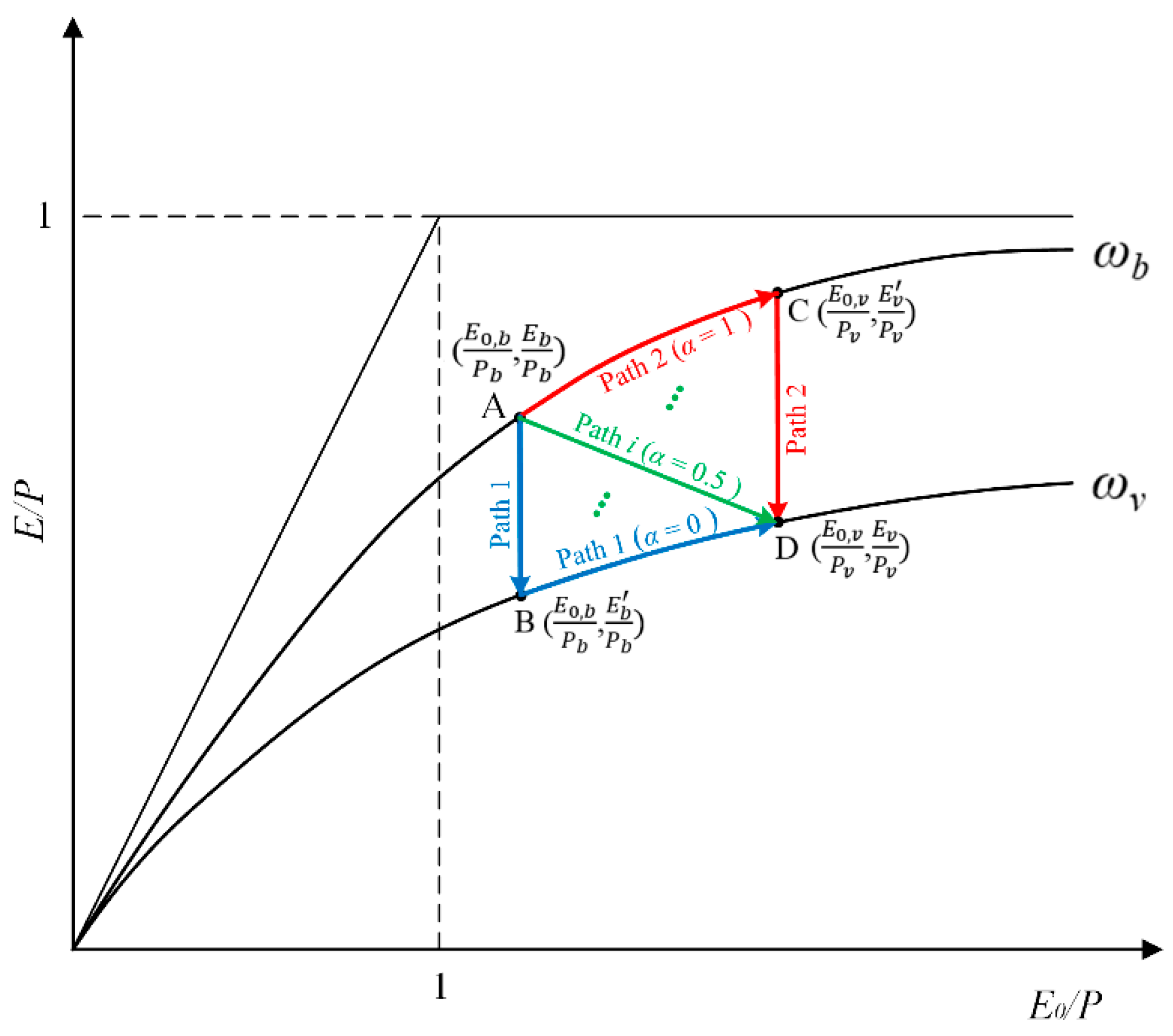
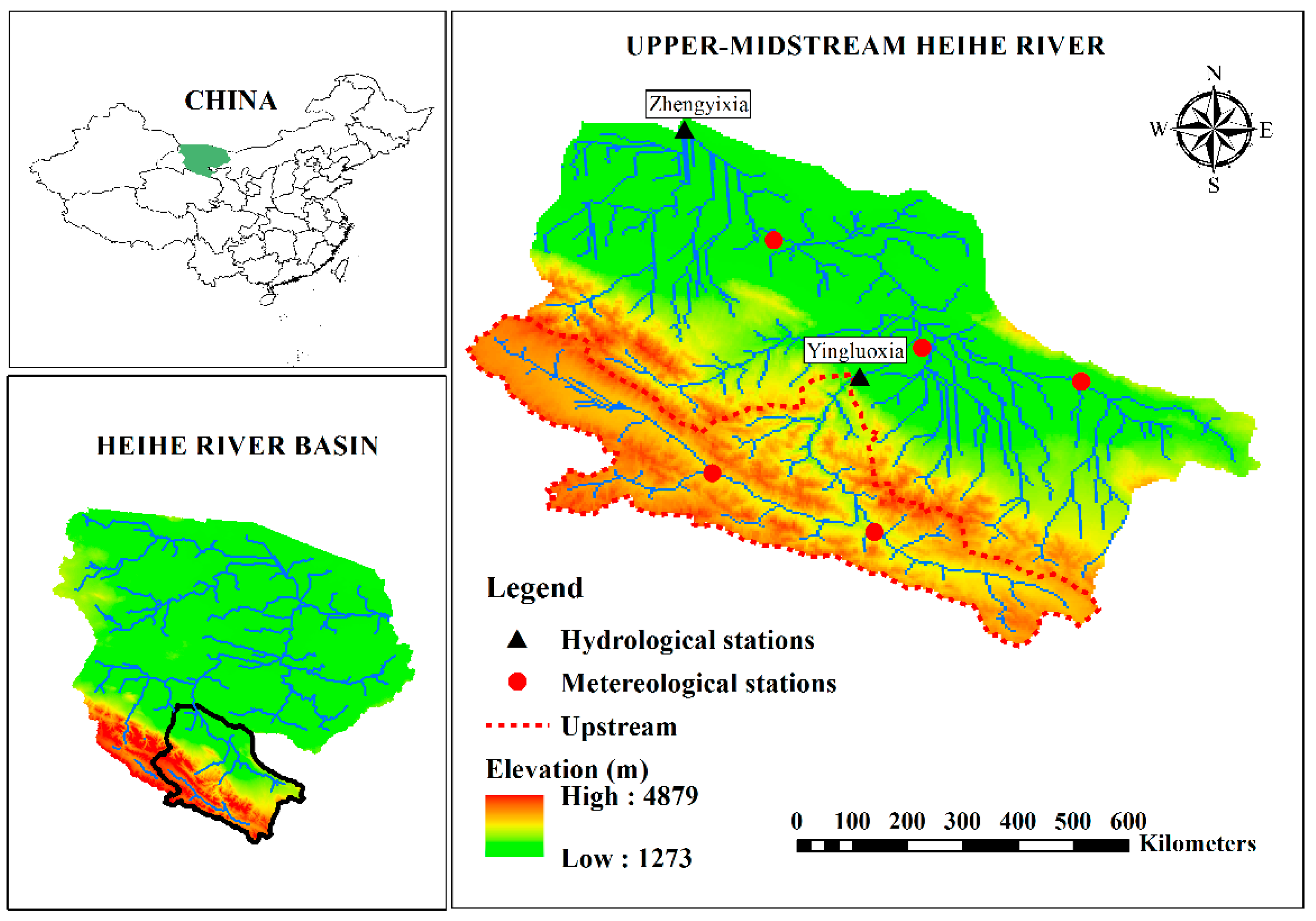

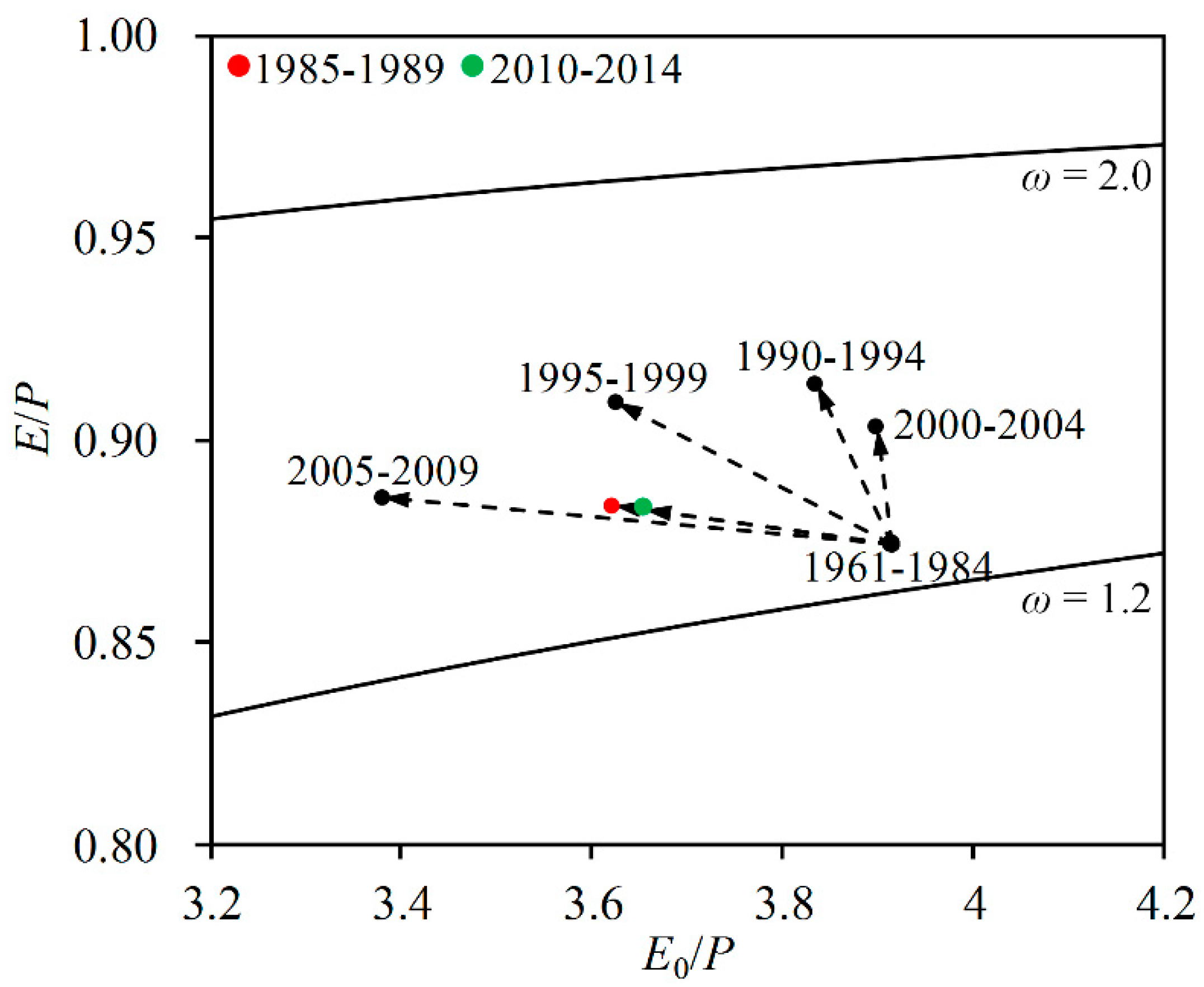
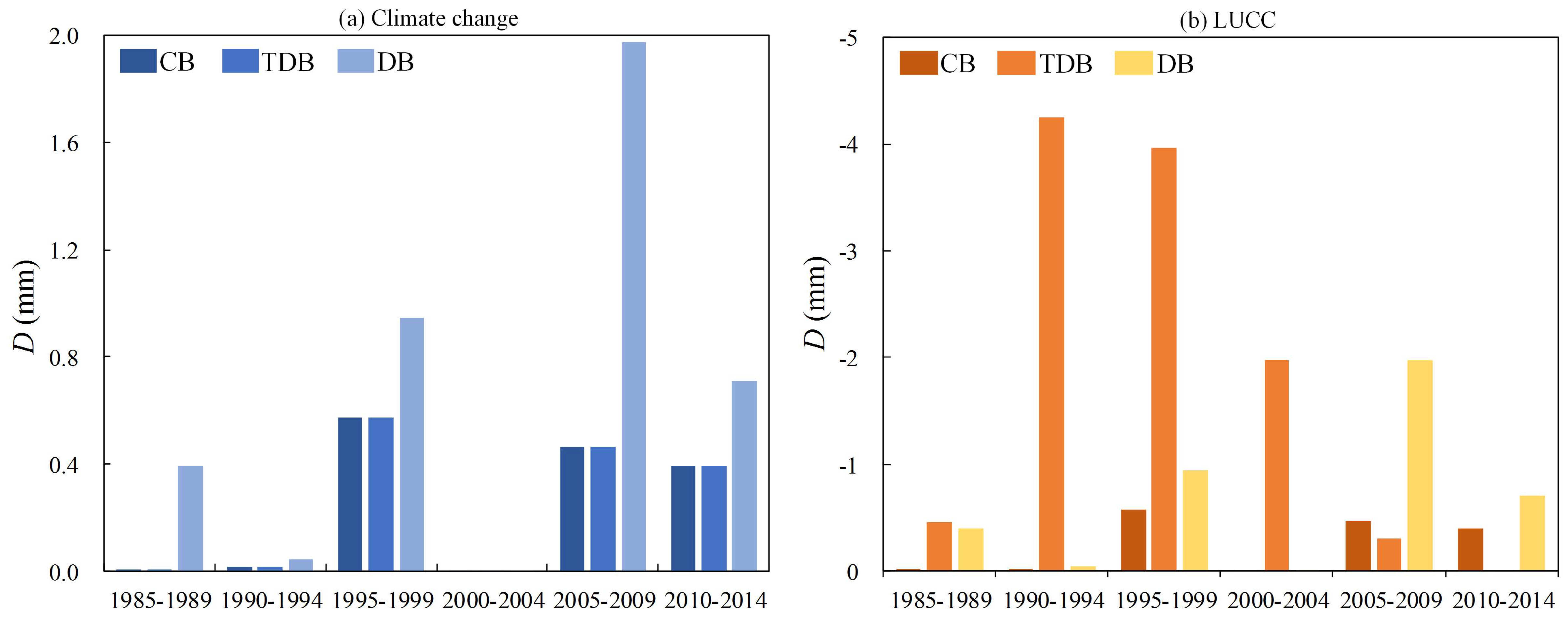
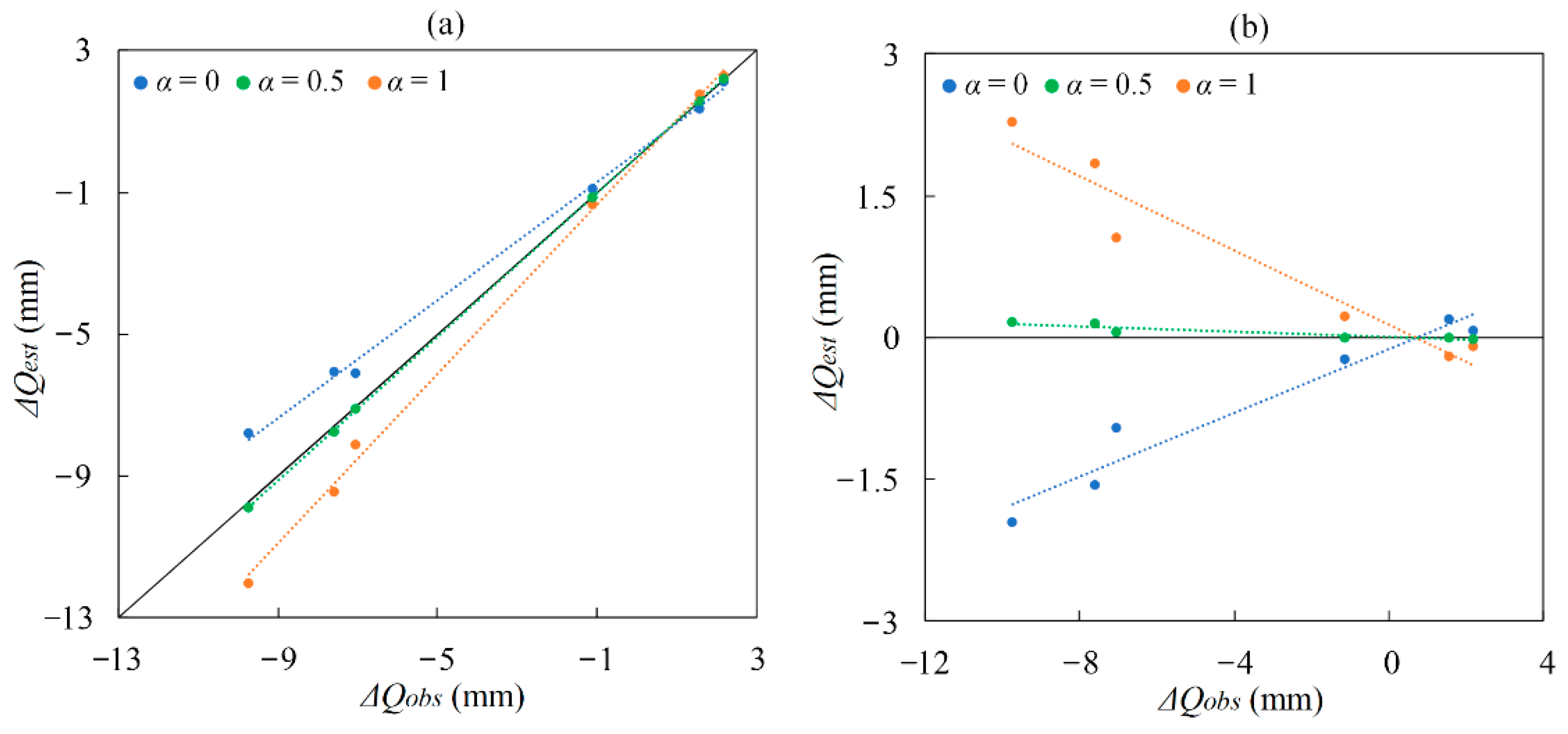

| Models | ||
|---|---|---|
| CB | ||
| TDB | ||
| The present DB |
| Parameter | P | E0 | Q |
|---|---|---|---|
| β (mm/yr) | 0.8 | 0.25 | −0.01 |
| Z | 2.40 *** | 0.67 | −0.13 |
| Annual Mean (mm/yr) | 251.09 | 946.49 | 28.47 |
| CB | TDB | DB | CB | TDB | DB | CB | TDB | DB | CB | TDB | DB | |
|---|---|---|---|---|---|---|---|---|---|---|---|---|
| The lower boundary (α = 0) | 3.71 | 3.71 | 3.57 | −7.34 | −6.90 | −7.20 | 33.58 | 34.99 | 33.15 | −66.42 | −65.01 | −66.85 |
| The upper boundary (α = 1) | 4.15 | 4.15 | 4.30 | −7.78 | −8.27 | −7.93 | 34.80 | 33.43 | 35.17 | −65.20 | −66.57 | −64.83 |
| In between (α = 0.5) | 3.93 | 3.93 | 3.94 | −7.56 | −7.59 | −7.57 | 34.22 | 34.15 | 34.22 | −65.78 | −65.85 | −65.78 |
| Land Use Types | Upstream/Midstream (2000) | |||||||
|---|---|---|---|---|---|---|---|---|
| Crop-Lands | Forest | Grass-Land | Water Bodies | Snow and Ice | Urban and Built-Up | Barren | ||
| Upstream (1980) | Croplands | 27 | 0 | 0 | 0 | 0 | 0 | 0 |
| Forest | 0 | 2107 | 0 | 0 | 0 | 0 | 0 | |
| Grassland | 0 | 0 | 4997 | 0 | 0 | 0 | 0 | |
| Water Bodies | 0 | 0 | 0 | 175 | 0 | 0 | 0 | |
| Snow and Ice | 0 | 2 | 51 | 0 | 76 | 0 | 99 | |
| Urban and Built-Up | 0 | 0 | 0 | 0 | 0 | 10 | 0 | |
| Barren | 0 | 0 | 0 | 0 | 0 | 0 | 2413 | |
| Midstream (1980) | Croplands | 3483 | 0 | 32 | 5 | 0 | 11 | 1 |
| Forest | 6 | 2427 | 16 | 0 | 0 | 0 | 9 | |
| Grassland | 226 | 5 | 7298 | 0 | 0 | 5 | 30 | |
| Water Bodies | 31 | 0 | 4 | 498 | 0 | 0 | 0 | |
| Snow and Ice | 0 | 0 | 0 | 0 | 57 | 0 | 11 | |
| Urban and Built-Up | 0 | 0 | 0 | 0 | 0 | 309 | 0 | |
| Barren | 46 | 0 | 3 | 1 | 0 | 4 | 10,511 | |
© 2020 by the authors. Licensee MDPI, Basel, Switzerland. This article is an open access article distributed under the terms and conditions of the Creative Commons Attribution (CC BY) license (http://creativecommons.org/licenses/by/4.0/).
Share and Cite
Xiong, M.; Huang, C.-S.; Yang, T. Assessing the Impacts of Climate Change and Land Use/Cover Change on Runoff Based on Improved Budyko Framework Models Considering Arbitrary Partition of the Impacts. Water 2020, 12, 1612. https://doi.org/10.3390/w12061612
Xiong M, Huang C-S, Yang T. Assessing the Impacts of Climate Change and Land Use/Cover Change on Runoff Based on Improved Budyko Framework Models Considering Arbitrary Partition of the Impacts. Water. 2020; 12(6):1612. https://doi.org/10.3390/w12061612
Chicago/Turabian StyleXiong, Manling, Ching-Sheng Huang, and Tao Yang. 2020. "Assessing the Impacts of Climate Change and Land Use/Cover Change on Runoff Based on Improved Budyko Framework Models Considering Arbitrary Partition of the Impacts" Water 12, no. 6: 1612. https://doi.org/10.3390/w12061612
APA StyleXiong, M., Huang, C.-S., & Yang, T. (2020). Assessing the Impacts of Climate Change and Land Use/Cover Change on Runoff Based on Improved Budyko Framework Models Considering Arbitrary Partition of the Impacts. Water, 12(6), 1612. https://doi.org/10.3390/w12061612





